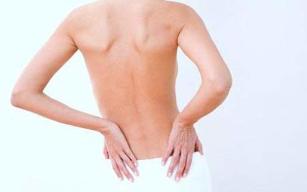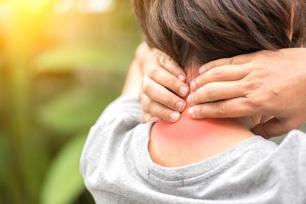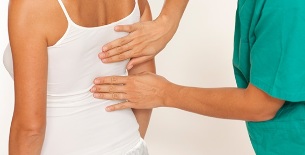
The spine performs the most important functions of the human body. From this article you will learn everything about what osteochondrosis is, what are the symptoms and treatment of this disease, what are the signs of pathology and the causes of the disease.
What is osteochondrosis
Osteochondrosis is a disease in which the intervertebral discs and other tissues of the spine are affected. Dystrophic processes are triggered within the spinal column. The vertebra, as it were, compresses, crushes these discs, which gradually leads to pinching the nerve endings of the spinal cord.
Important! If osteochondrosis is not treated, the pathology can cause disability.
Approximately 80% of the world population suffers from spinal diseases. Osteochondrosis is most often diagnosed in people ages 15 to 30. Although the disease occurs in both men and women, a strong half of humanity is more difficult to tolerate this ailment.
The disease begins to develop and manifest itself in relatively adulthood, when a person leads an active life. Although osteochondrosis is possible in children, it occurs much less frequently than in adults.
Despite the fact that experts from around the world have come together to eradicate the disease, every year new cases of osteochondrosis are registered. Whether problems arise depends largely on the individual's personal efforts.
Existing classification
There are many types of osteochondrosis, so different doctors may apply different classifications.
Depending on the part of the spine affected, there are:
- cervical osteochondrosis;
- osteochondrosis of the thoracic spine;
- osteochondrosis of the lumbar spine;
- osteochondrosis of the sacral region.
There is also extensive osteochondrosis. This is a form of pathology in which several departments are affected at the same time. For example, osteochondrosis of the lumbosacral region is often found, since it is this part of the spine that experiences a constant increase in load.
Regardless of the type of illness a person has, complications are always serious. Therefore, it is important to identify the disease as early as possible and provide qualified first aid.
When a doctor makes a diagnosis, he looks at what stage the pathology is detected at. With osteochondrosis, 3 stages are distinguished based on the image of an X-ray examination and 4 stages based on symptomatic changes.
What happens during the pathology
Almost all vertebrae have a similar structure. They consist of a vertebral body and an arch. All the vertebrae, "folded" together, form a spinal canal. The discs are located between the vertebrae, gelatinous tendons that act as shock absorbers.
It is in the intervertebral discs with osteochondrosis that pathological changes begin. The fibrous part gradually becomes more brittle. Under the pressure of the vertebrae, the nucleus pulposus moves on its own and looks for a place where it is easier to do so.
In most cases, the disc exits the spinal canal. This leads to compression of the spinal cord and the nerves located there. The result is pain and symptoms in the organs for which these nerves are responsible.
In response to pressure in the body, the processes of accelerated division of bone tissue are triggered. As a result, the development of osteophytes begins - bone growths that cause a person the main problems of osteochondrosis.
So, with osteochondrosis of the cervical spine, the consequences can be sad, since the pathological process simultaneously affects both the nervous and vascular systems.
Causes of osteochondrosis
Since osteochondrosis is a dangerous enemy, it is important to understand what triggers the onset of the disease. Regardless of where the disease is located, its causes are always similar.
The main reasons why osteochondrosis can develop are the following:
- premature aging of intervertebral disc tissues;
- constant overexertion of the muscles that support the spine;
- reasonable lack of stress on these muscle groups;
- uneven distribution of load between parts of the spine, leading to imbalance and the development of pseudospondylolisthesis;
- the presence of a genetic predisposition to the development of degenerative processes in cartilaginous tissues;
- the presence of autoimmune diseases, due to which the antibodies themselves interrupt the nutrition of the spine.
Without a doubt, hormonal imbalances and poor diet can also affect the health of the spine. Some women experienced the first symptoms of the disease during pregnancy when workload increased.
Risk Group
Acute osteochondrosis usually develops after exposure to negative factors. The following factors can trigger the appearance of symptoms:
- wrong posture;
- sedentary lifestyle;
- prolonged positioning in an awkward position;
- lift heavy weights;
- scoliosis;
- missing a spinal muscular corset;
- lack of vitamins and minerals necessary for the regeneration of bone and cartilage tissue;
- emotional experiences;
- serious infections;
- impact of an unfavorable ecology;
- prolonged hypothermia;
- gets injured;
- abrupt changes in body position;
- power sports;
- wearing shoes with uncomfortable heels;
- being overweight;
- metabolic disorders;
- rheumatism;
- congenital malformations.
As you can see, many factors can provoke the development of osteochondrosis. However, the sooner the first signs of the disease are discovered and the diagnosis is made, the more possibilities there are to cure the pathology and preserve the quality of life.
Characteristics of the disease by stages
There are 4 stages of the disease and each one has its own intensity of symptoms:
- with grade 1 disease, the patient does not experience general symptoms, but may only have local pain;
- with osteochondrosis of the second degree, the pain becomes stronger, disc protrusions and subluxation of the vertebral bodies develop, violations of statics are observed;
- for grade 3 osteochondrosis, significant symptoms, including general ones, are characteristic and the lesion reaches the developmental stage of an intervertebral hernia;
- In 4 stages of the pathology, disability occurs and no medication no longer provides relief.
Of course, if osteochondrosis is detected in the early stage, it is quite possible to stop the progression of the disease.
However, intervertebral osteochondrosis is divided according to damage to the vertebral body:
- with no violations at stage 0;
- in the 1st stage the alterations are insignificant, sometimes there are internal tears in the vertebrae;
- in the second stage, the changes in the disk are quite remarkable and expressed, however, the outer surface is preserved;
- In the third stage, the disc is completely affected, squeezed into the spinal cord area or outward.
If you experience minor symptoms, including instability of the lumbar spine or discomfort in any other area, you should consult a specialist for advice.
Symptoms of osteochondrosis
As already noted, the intensity of symptoms depends on the degree of damage to the vertebral body and the location of the damage. Most patients report similar symptoms.
When the pathological process is located in the cervical spine, the following symptoms are possible:
- blurred vision;
- ear congestion;
- head noise;
- ringing in the ears;
- dizziness;
- headaches;
- sleep apnea;
- hearing impairment;
- fainting;
- weakness of the vocal cords;
- neck cramps;
- changes in blood pressure;
- numbness of the tongue;
- neck swelling;
- eye pain;
- insomnia;
- vasospasm of the neck;
- dental problems.

With spinal injuries in the thoracic region, the following phenomena occur:
- muscle spasm, similar to cutting, stabbing and sharp heart pains;
- the patient has difficulty breathing;
- pain and burning in the sternum;
- there is a lump in the throat;
- possible cough and nausea;
- pains appear in the abdomen, especially during deep inhalation and exhalation;
- there is severe weakness in the arms and legs;
- discomfort increases with a change in body position.
For problems in the sacral or lumbar spine, the following complaints appear:
- back pain radiating to the legs;
- frostbite of the lower extremities at normal body temperature;
- numbness in the legs;
- constant tension in the leg muscles;
- varicose veins;
- impotence;
- pale skin;
- dysmenorrhea.
As osteochondrosis of the back progresses, several vertebrae may fuse together. Then the symptomatology gradually fades, but reappears during the spring-autumn exacerbation.
If the vagus nerve is pinched, digestion, heart rate, and bladder and bladder problems can occur.
Syndromes in osteochondrosis
It is customary among physicians to divide symptoms into groups, syndromes. With intercostal osteochondrosis, there are:
- vertebral syndrome;
- vertebral artery syndrome;
- cardiac or scapular rib syndrome;
- root.
Each of the syndromes is worth a closer look.
Vertebral
With vertebral syndrome, the following image is observed:
- mobility is impaired and neck pain occurs;
- changes in the state of the vertebrae are visible on the radiograph;
- the patient cannot turn his head to the side without pain.
Important! When diagnosing, the doctor must differentiate myositis and vertebral syndrome, since the clinical picture is similar, but the treatment methods are different.
Vertebral artery
With this osteochondrosis syndrome, the following manifestations are observed:
- nausea, vomiting;
- pressure peaks;
- dizziness;
- migraines;
- flies into the eyes;
- drowsiness;
- lethargy;
- fatigue;
- violation of emotional stability.
The physician must differentiate this syndrome from atherosclerotic changes in vessels and tumor processes.
Cardiac
This syndrome is characterized by:
- burns;
- chest pain;
- shortness of breath;
- tiredness;
- tachycardia.
When visiting a hospital, an ECG and angiography should be performed, confirming the absence of atherosclerosis.
Radicular
Pathological signs depend on which roots have undergone changes. In general, this group of symptoms includes:
- discomfort in the occipital area;
- unpleasant sensations in the language;
- Difficulty chewing food;
- pain when swallowing;
- discomfort in the scapular area;
- Difficulty performing hand movements;
- no possession of 4 and 5 fingers.
Since most of the time various parts of the spine are involved in the pathological process of osteochondrosis, whole groups of symptoms arise.

Diagnosis
When symptoms of osteochondrosis appear, as a rule, tests are not carried out.
Some of the following tests are sufficient to make a diagnosis:
- radiography;
- computed tomography;
- magnetic resonance imaging.
Although a conventional X-ray examination allows a diagnosis, CT and MRI are used to more effectively select medications and determine the degree of damage to the spine.
Treatment of osteochondrosis
Both during an exacerbation and during planned therapy, treatment must be comprehensive. Applies to:
- drug treatment;
- manual therapy;
- Exercise therapy for osteochondrosis.
The most common treatment is at home. The main thing is that the patient strictly adheres to the doctor's prescription. When a patient needs injections, a day hospital may be recommended.
Peculiarities of pharmacological treatment
Drug treatment involves the use of several groups of drugs at the same time. Nonsteroidal anti-inflammatory drugs are prescribed.
NSAIDs are initially prescribed as ointments. As the disease progresses, tablets, injections, or another form of antispasmodic may be recommended. Almost all non-steroidal anti-inflammatory drugs have a pronounced analgesic effect.
In order for the spine to relax, it needs to relieve muscle spasm. For these purposes, muscle relaxants are used.
If treatment is started in the early stages of the disease, when the cartilage tissue has not yet been destroyed, it makes sense to take chondroprotectants.
Important! For all of these medications to have any effect, they must be taken consistently, for at least six months.
Vitamin B complexes can have a positive effect on recovery.
The following medications may also be prescribed:
- to expand blood vessels and improve nutrition;
- to combat vertigo;
- topical gel to improve blood circulation.
Compresses, mustard plasters and special anesthetic plasters with a medicinal composition are placed on the affected areas.
Performing Manual Therapy
Although massage of the neck and other affected areas is believed to be a popular method, this judgment is wrong. Such procedures can only be carried out after a doctor's prescription and careful training. Wrong actions can cause even more damage.
You can massage with honey or any medicinal oil. The following techniques are used:
- light strokes are made with the fingertips, starting from the head to the upper part of the back;
- rubbing in progress;
- squeeze to engage deep layers of tissue;
- kneading.
The cupping massage is effective. Self-massage can be performed. It is highly undesirable to use massagers without consulting your doctor, as reckless influence can damage already fragile discs.
The value of exercise therapy in osteochondrosis
To get rid of the symptoms of osteochondrosis, it is important to regularly perform a series of exercises for the back. Now there are many popular techniques for lumbar and cervical corset training. Let's consider only the most effective and briefly analyze their essence.
Kinesitherapy Physician Neck Gymnastics helps improve blood circulation, relieve pain, and restore freedom of movement. It does not give a quick effect, the result is only after long-term therapy. In addition to exercising, it is important to consider prescribed treatment and follow the diet. All exercises are performed at a very slow pace, in the process, proper muscle stretching is ensured.
Other doctor's therapeutic neck exercises for osteochondrosis are useful not only for people with osteochondrosis, but also for many other problems. The complex resembles more exercises for the neck, and classes can be held even at lunchtime. To achieve results and strengthen muscles, you must exercise regularly and only after your doctor's appointment.
General recommendations in the treatment of osteochondrosis
Since osteochondrosis patients need careful periodic warming, a visit to the bathroom will be helpful for such a patient. It is only important to take into account the stage of the disease and the presence of other pathologies. Before such a procedure, you should consult a doctor.
To strengthen the muscle corset, you can use push-ups, fitness, and Pilates with a trainer. It is necessary to visit the pool regularly. Each swimming session should not last less than 20 minutes, otherwise there will be no effect.
Treatment with folk remedies is allowed, but only after agreement with the attending physician and as auxiliary therapy. Physical therapy, including electrophoresis, can be performed as directed by a physician.
Prevention
Even if the problems with the spine seem insignificant, or if the patient is still a child, it is important to actively participate in the prevention of osteochondrosis.
It is important to observe the following best practices:
- use orthopedic pillows to sleep;
- lead an active lifestyle;
- set aside time for sports, especially swimming;
- heat several times a day;
- be careful when doing physically demanding work;
- give up bad habits.
Diet is important, as certain foods increase the risk of disease, namely:
- salting;
- smoked meats;
- spices;
- sweets;
- fatty and fried foods.
It is important to limit soft drinks and coffee, and it is better to give preference to tea and broths. Proper nutrition will help protect the body from damage to bone and cartilage tissue.
Since in the initial stages of osteochondrosis the process can be stopped and even reversed, it is necessary to immediately consult a doctor and undergo an examination when the first symptoms appear. This is the only way to stay physically active for many years!

























